HRMT 151 - Labor Relations Analysis: Bargaining Power Assessment
VerifiedAdded on 2023/06/03
|7
|2057
|114
Report
AI Summary
This report analyzes three scenarios related to labor relations and bargaining power, as outlined in HRMT 151. The assignment assesses the bargaining power of employers and unions in each case, considering factors such as market competitiveness, wage parity, and the impact of strikes. The report examines the positions of both the employer and the union in each scenario, evaluating their strengths and weaknesses based on internal and external inputs. The analysis considers aspects such as the company's financial performance, the union's demands, and the impact of potential labor actions. The report provides a detailed assessment of the bargaining dynamics, ultimately determining which party possesses greater power in each situation, supported by references.
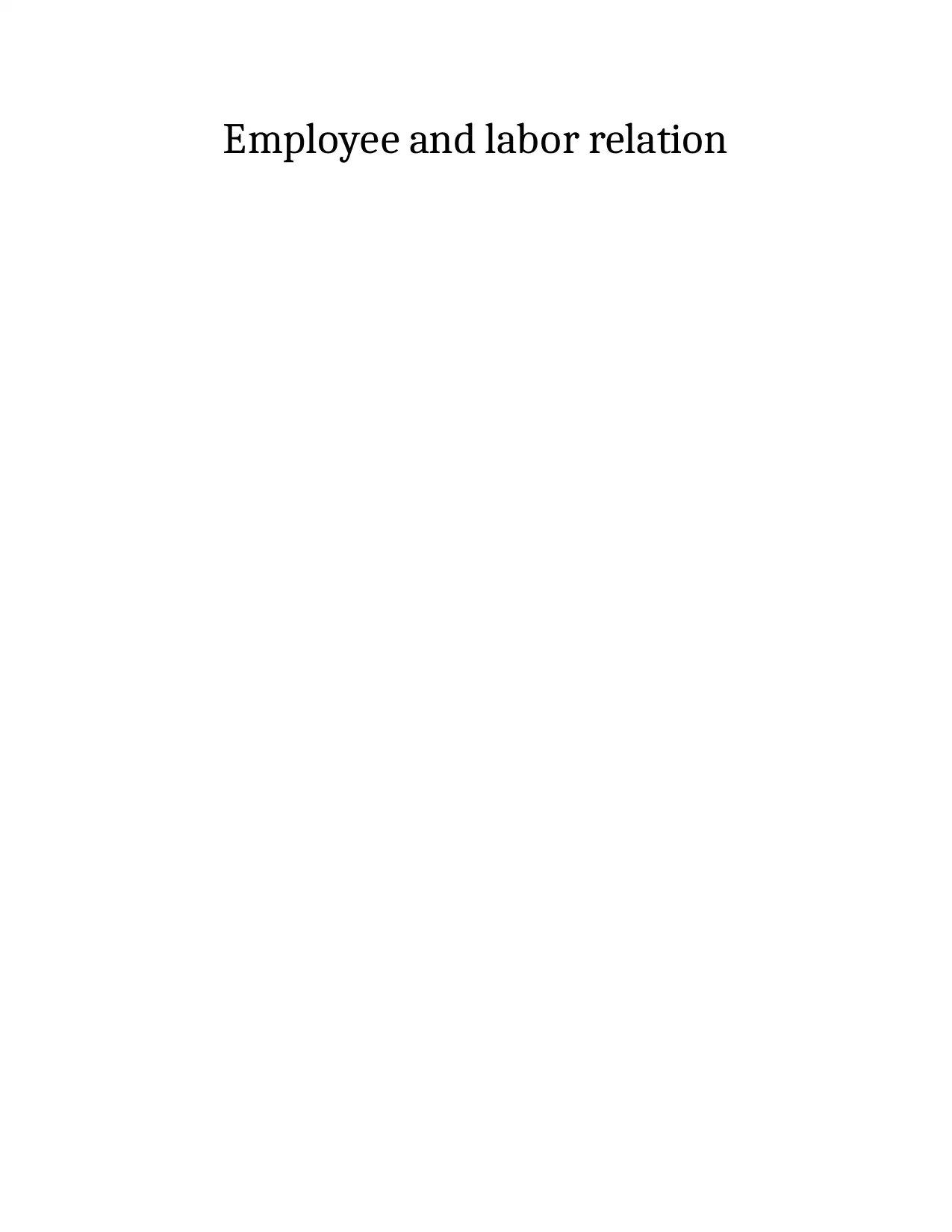
Employee and labor relation
Paraphrase This Document
Need a fresh take? Get an instant paraphrase of this document with our AI Paraphraser
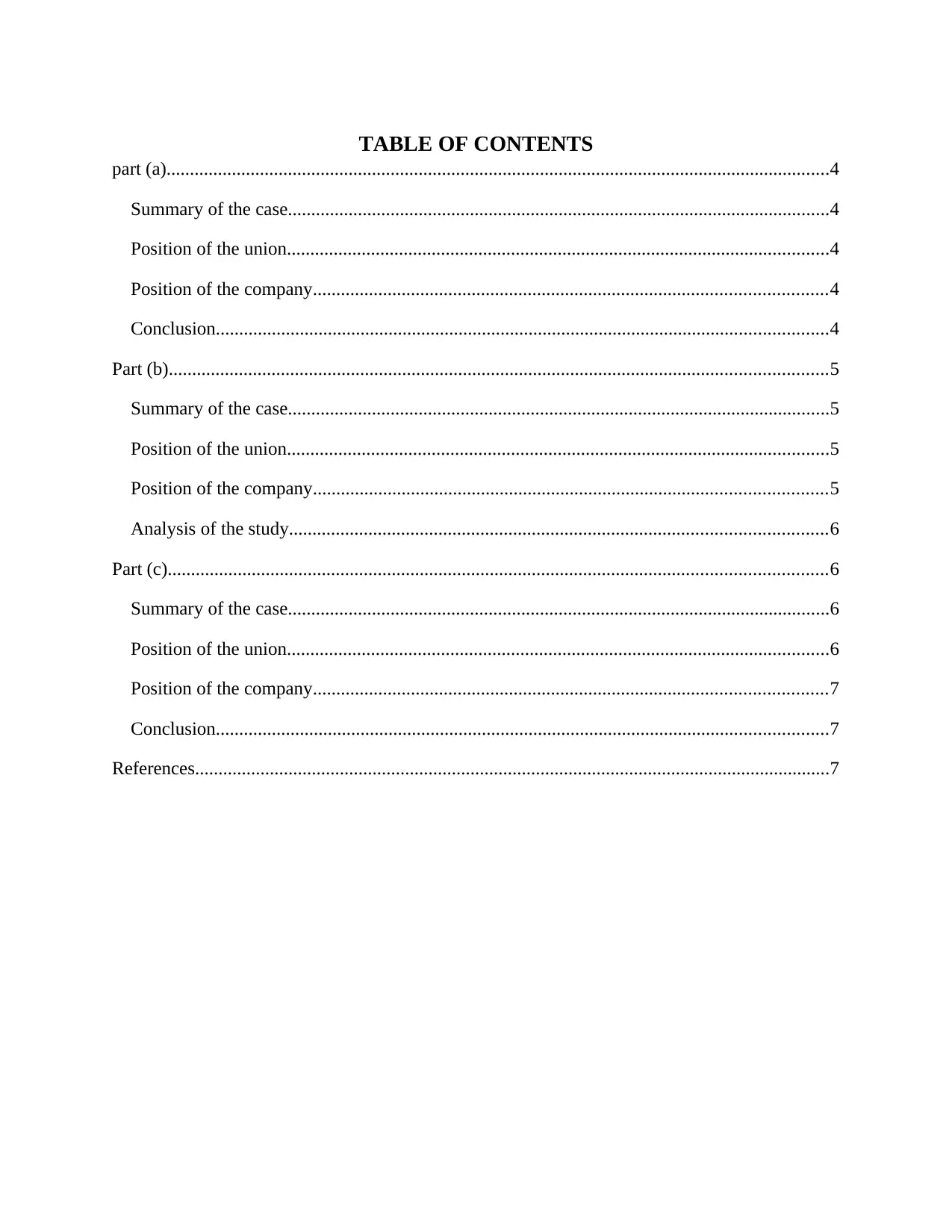
TABLE OF CONTENTS
part (a)..............................................................................................................................................4
Summary of the case....................................................................................................................4
Position of the union....................................................................................................................4
Position of the company..............................................................................................................4
Conclusion...................................................................................................................................4
Part (b).............................................................................................................................................5
Summary of the case....................................................................................................................5
Position of the union....................................................................................................................5
Position of the company..............................................................................................................5
Analysis of the study...................................................................................................................6
Part (c).............................................................................................................................................6
Summary of the case....................................................................................................................6
Position of the union....................................................................................................................6
Position of the company..............................................................................................................7
Conclusion...................................................................................................................................7
References........................................................................................................................................7
part (a)..............................................................................................................................................4
Summary of the case....................................................................................................................4
Position of the union....................................................................................................................4
Position of the company..............................................................................................................4
Conclusion...................................................................................................................................4
Part (b).............................................................................................................................................5
Summary of the case....................................................................................................................5
Position of the union....................................................................................................................5
Position of the company..............................................................................................................5
Analysis of the study...................................................................................................................6
Part (c).............................................................................................................................................6
Summary of the case....................................................................................................................6
Position of the union....................................................................................................................6
Position of the company..............................................................................................................7
Conclusion...................................................................................................................................7
References........................................................................................................................................7
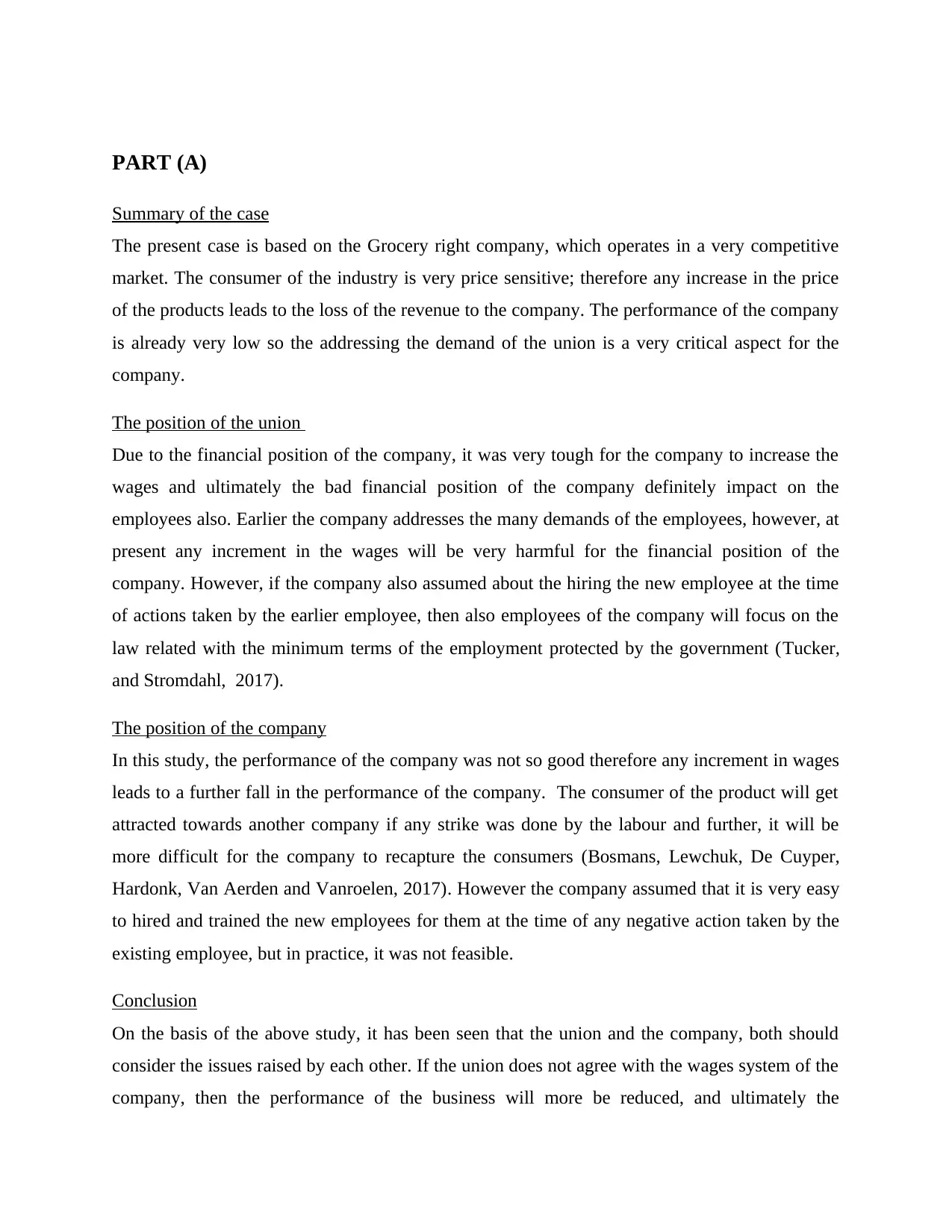
PART (A)
Summary of the case
The present case is based on the Grocery right company, which operates in a very competitive
market. The consumer of the industry is very price sensitive; therefore any increase in the price
of the products leads to the loss of the revenue to the company. The performance of the company
is already very low so the addressing the demand of the union is a very critical aspect for the
company.
The position of the union
Due to the financial position of the company, it was very tough for the company to increase the
wages and ultimately the bad financial position of the company definitely impact on the
employees also. Earlier the company addresses the many demands of the employees, however, at
present any increment in the wages will be very harmful for the financial position of the
company. However, if the company also assumed about the hiring the new employee at the time
of actions taken by the earlier employee, then also employees of the company will focus on the
law related with the minimum terms of the employment protected by the government (Tucker,
and Stromdahl, 2017).
The position of the company
In this study, the performance of the company was not so good therefore any increment in wages
leads to a further fall in the performance of the company. The consumer of the product will get
attracted towards another company if any strike was done by the labour and further, it will be
more difficult for the company to recapture the consumers (Bosmans, Lewchuk, De Cuyper,
Hardonk, Van Aerden and Vanroelen, 2017). However the company assumed that it is very easy
to hired and trained the new employees for them at the time of any negative action taken by the
existing employee, but in practice, it was not feasible.
Conclusion
On the basis of the above study, it has been seen that the union and the company, both should
consider the issues raised by each other. If the union does not agree with the wages system of the
company, then the performance of the business will more be reduced, and ultimately the
Summary of the case
The present case is based on the Grocery right company, which operates in a very competitive
market. The consumer of the industry is very price sensitive; therefore any increase in the price
of the products leads to the loss of the revenue to the company. The performance of the company
is already very low so the addressing the demand of the union is a very critical aspect for the
company.
The position of the union
Due to the financial position of the company, it was very tough for the company to increase the
wages and ultimately the bad financial position of the company definitely impact on the
employees also. Earlier the company addresses the many demands of the employees, however, at
present any increment in the wages will be very harmful for the financial position of the
company. However, if the company also assumed about the hiring the new employee at the time
of actions taken by the earlier employee, then also employees of the company will focus on the
law related with the minimum terms of the employment protected by the government (Tucker,
and Stromdahl, 2017).
The position of the company
In this study, the performance of the company was not so good therefore any increment in wages
leads to a further fall in the performance of the company. The consumer of the product will get
attracted towards another company if any strike was done by the labour and further, it will be
more difficult for the company to recapture the consumers (Bosmans, Lewchuk, De Cuyper,
Hardonk, Van Aerden and Vanroelen, 2017). However the company assumed that it is very easy
to hired and trained the new employees for them at the time of any negative action taken by the
existing employee, but in practice, it was not feasible.
Conclusion
On the basis of the above study, it has been seen that the union and the company, both should
consider the issues raised by each other. If the union does not agree with the wages system of the
company, then the performance of the business will more be reduced, and ultimately the
⊘ This is a preview!⊘
Do you want full access?
Subscribe today to unlock all pages.

Trusted by 1+ million students worldwide
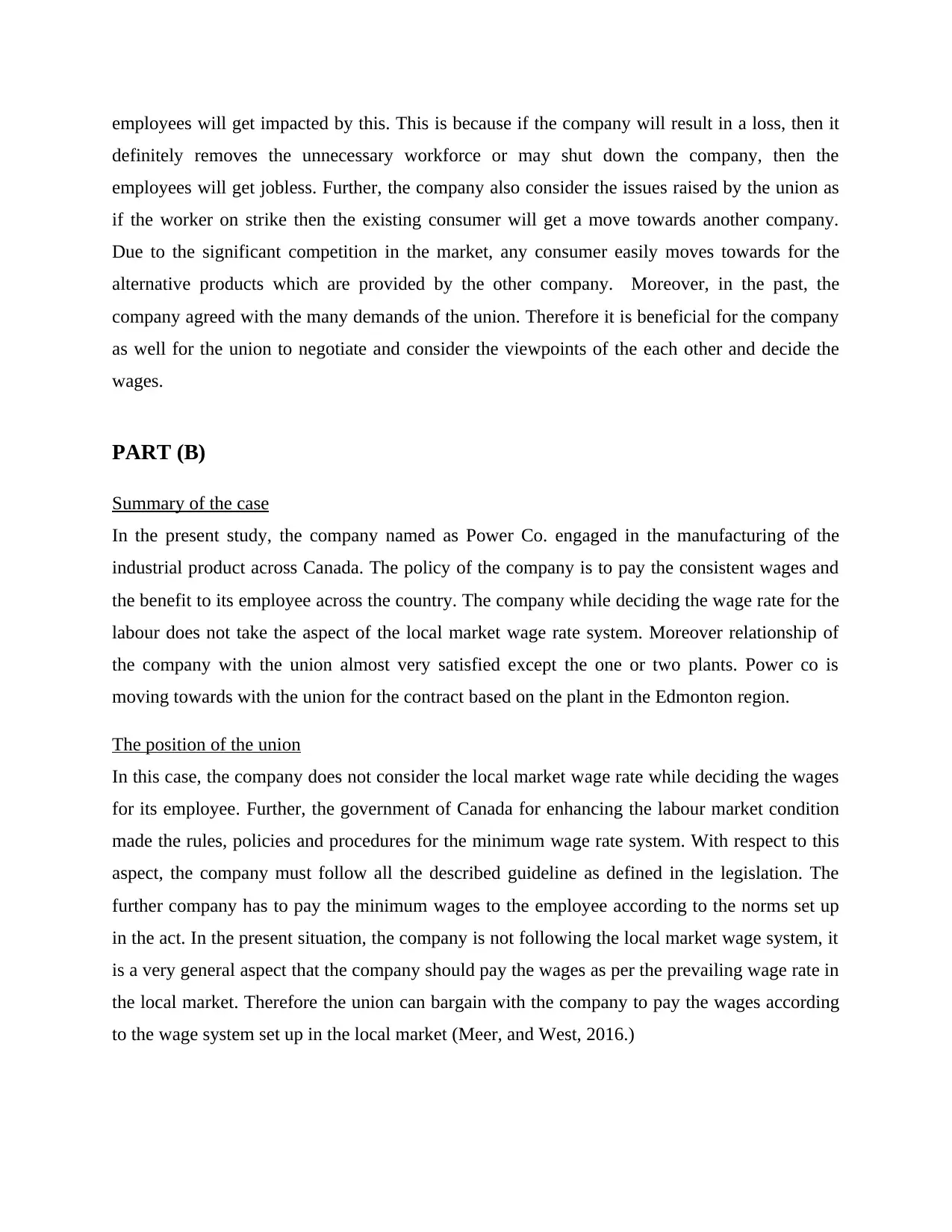
employees will get impacted by this. This is because if the company will result in a loss, then it
definitely removes the unnecessary workforce or may shut down the company, then the
employees will get jobless. Further, the company also consider the issues raised by the union as
if the worker on strike then the existing consumer will get a move towards another company.
Due to the significant competition in the market, any consumer easily moves towards for the
alternative products which are provided by the other company. Moreover, in the past, the
company agreed with the many demands of the union. Therefore it is beneficial for the company
as well for the union to negotiate and consider the viewpoints of the each other and decide the
wages.
PART (B)
Summary of the case
In the present study, the company named as Power Co. engaged in the manufacturing of the
industrial product across Canada. The policy of the company is to pay the consistent wages and
the benefit to its employee across the country. The company while deciding the wage rate for the
labour does not take the aspect of the local market wage rate system. Moreover relationship of
the company with the union almost very satisfied except the one or two plants. Power co is
moving towards with the union for the contract based on the plant in the Edmonton region.
The position of the union
In this case, the company does not consider the local market wage rate while deciding the wages
for its employee. Further, the government of Canada for enhancing the labour market condition
made the rules, policies and procedures for the minimum wage rate system. With respect to this
aspect, the company must follow all the described guideline as defined in the legislation. The
further company has to pay the minimum wages to the employee according to the norms set up
in the act. In the present situation, the company is not following the local market wage system, it
is a very general aspect that the company should pay the wages as per the prevailing wage rate in
the local market. Therefore the union can bargain with the company to pay the wages according
to the wage system set up in the local market (Meer, and West, 2016.)
definitely removes the unnecessary workforce or may shut down the company, then the
employees will get jobless. Further, the company also consider the issues raised by the union as
if the worker on strike then the existing consumer will get a move towards another company.
Due to the significant competition in the market, any consumer easily moves towards for the
alternative products which are provided by the other company. Moreover, in the past, the
company agreed with the many demands of the union. Therefore it is beneficial for the company
as well for the union to negotiate and consider the viewpoints of the each other and decide the
wages.
PART (B)
Summary of the case
In the present study, the company named as Power Co. engaged in the manufacturing of the
industrial product across Canada. The policy of the company is to pay the consistent wages and
the benefit to its employee across the country. The company while deciding the wage rate for the
labour does not take the aspect of the local market wage rate system. Moreover relationship of
the company with the union almost very satisfied except the one or two plants. Power co is
moving towards with the union for the contract based on the plant in the Edmonton region.
The position of the union
In this case, the company does not consider the local market wage rate while deciding the wages
for its employee. Further, the government of Canada for enhancing the labour market condition
made the rules, policies and procedures for the minimum wage rate system. With respect to this
aspect, the company must follow all the described guideline as defined in the legislation. The
further company has to pay the minimum wages to the employee according to the norms set up
in the act. In the present situation, the company is not following the local market wage system, it
is a very general aspect that the company should pay the wages as per the prevailing wage rate in
the local market. Therefore the union can bargain with the company to pay the wages according
to the wage system set up in the local market (Meer, and West, 2016.)
Paraphrase This Document
Need a fresh take? Get an instant paraphrase of this document with our AI Paraphraser
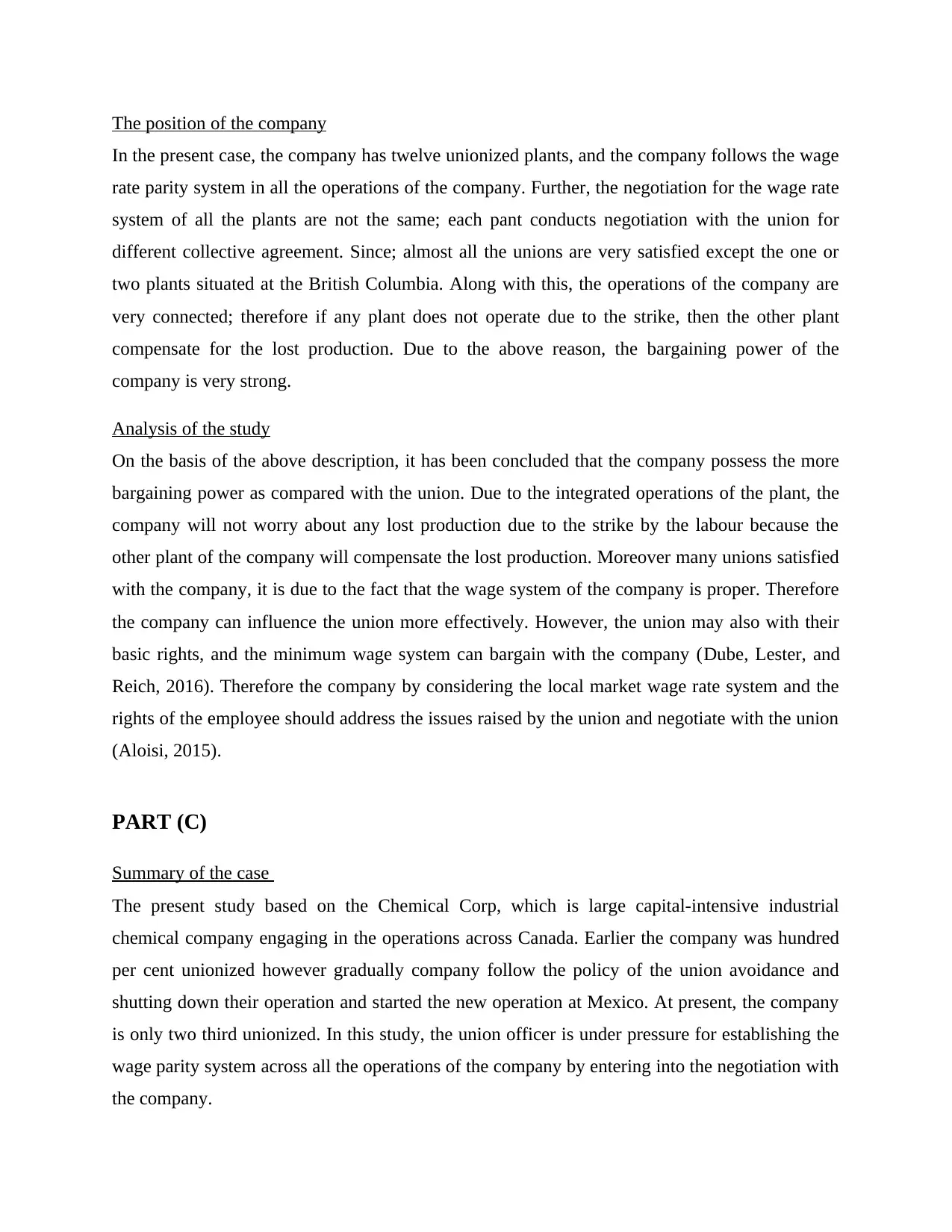
The position of the company
In the present case, the company has twelve unionized plants, and the company follows the wage
rate parity system in all the operations of the company. Further, the negotiation for the wage rate
system of all the plants are not the same; each pant conducts negotiation with the union for
different collective agreement. Since; almost all the unions are very satisfied except the one or
two plants situated at the British Columbia. Along with this, the operations of the company are
very connected; therefore if any plant does not operate due to the strike, then the other plant
compensate for the lost production. Due to the above reason, the bargaining power of the
company is very strong.
Analysis of the study
On the basis of the above description, it has been concluded that the company possess the more
bargaining power as compared with the union. Due to the integrated operations of the plant, the
company will not worry about any lost production due to the strike by the labour because the
other plant of the company will compensate the lost production. Moreover many unions satisfied
with the company, it is due to the fact that the wage system of the company is proper. Therefore
the company can influence the union more effectively. However, the union may also with their
basic rights, and the minimum wage system can bargain with the company (Dube, Lester, and
Reich, 2016). Therefore the company by considering the local market wage rate system and the
rights of the employee should address the issues raised by the union and negotiate with the union
(Aloisi, 2015).
PART (C)
Summary of the case
The present study based on the Chemical Corp, which is large capital-intensive industrial
chemical company engaging in the operations across Canada. Earlier the company was hundred
per cent unionized however gradually company follow the policy of the union avoidance and
shutting down their operation and started the new operation at Mexico. At present, the company
is only two third unionized. In this study, the union officer is under pressure for establishing the
wage parity system across all the operations of the company by entering into the negotiation with
the company.
In the present case, the company has twelve unionized plants, and the company follows the wage
rate parity system in all the operations of the company. Further, the negotiation for the wage rate
system of all the plants are not the same; each pant conducts negotiation with the union for
different collective agreement. Since; almost all the unions are very satisfied except the one or
two plants situated at the British Columbia. Along with this, the operations of the company are
very connected; therefore if any plant does not operate due to the strike, then the other plant
compensate for the lost production. Due to the above reason, the bargaining power of the
company is very strong.
Analysis of the study
On the basis of the above description, it has been concluded that the company possess the more
bargaining power as compared with the union. Due to the integrated operations of the plant, the
company will not worry about any lost production due to the strike by the labour because the
other plant of the company will compensate the lost production. Moreover many unions satisfied
with the company, it is due to the fact that the wage system of the company is proper. Therefore
the company can influence the union more effectively. However, the union may also with their
basic rights, and the minimum wage system can bargain with the company (Dube, Lester, and
Reich, 2016). Therefore the company by considering the local market wage rate system and the
rights of the employee should address the issues raised by the union and negotiate with the union
(Aloisi, 2015).
PART (C)
Summary of the case
The present study based on the Chemical Corp, which is large capital-intensive industrial
chemical company engaging in the operations across Canada. Earlier the company was hundred
per cent unionized however gradually company follow the policy of the union avoidance and
shutting down their operation and started the new operation at Mexico. At present, the company
is only two third unionized. In this study, the union officer is under pressure for establishing the
wage parity system across all the operations of the company by entering into the negotiation with
the company.
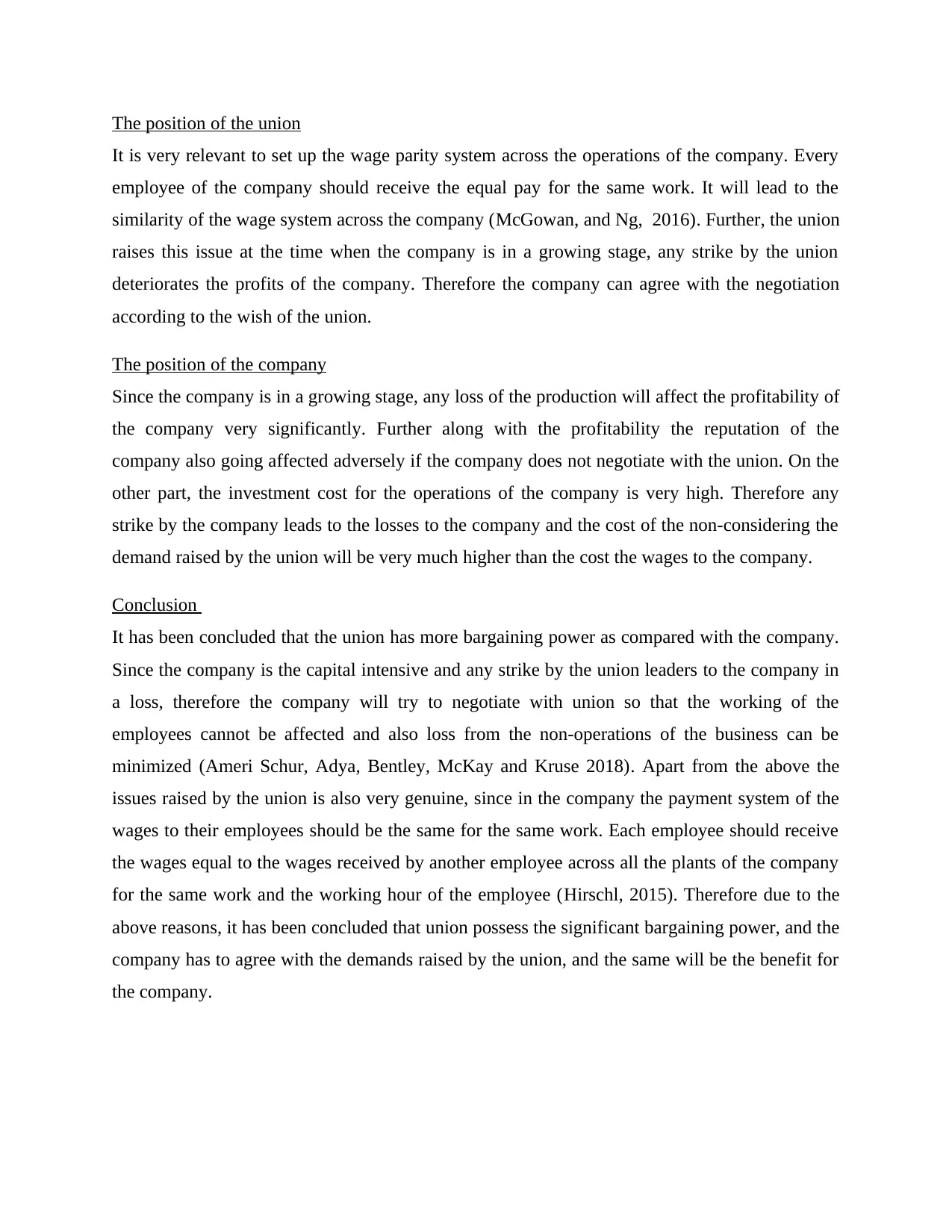
The position of the union
It is very relevant to set up the wage parity system across the operations of the company. Every
employee of the company should receive the equal pay for the same work. It will lead to the
similarity of the wage system across the company (McGowan, and Ng, 2016). Further, the union
raises this issue at the time when the company is in a growing stage, any strike by the union
deteriorates the profits of the company. Therefore the company can agree with the negotiation
according to the wish of the union.
The position of the company
Since the company is in a growing stage, any loss of the production will affect the profitability of
the company very significantly. Further along with the profitability the reputation of the
company also going affected adversely if the company does not negotiate with the union. On the
other part, the investment cost for the operations of the company is very high. Therefore any
strike by the company leads to the losses to the company and the cost of the non-considering the
demand raised by the union will be very much higher than the cost the wages to the company.
Conclusion
It has been concluded that the union has more bargaining power as compared with the company.
Since the company is the capital intensive and any strike by the union leaders to the company in
a loss, therefore the company will try to negotiate with union so that the working of the
employees cannot be affected and also loss from the non-operations of the business can be
minimized (Ameri Schur, Adya, Bentley, McKay and Kruse 2018). Apart from the above the
issues raised by the union is also very genuine, since in the company the payment system of the
wages to their employees should be the same for the same work. Each employee should receive
the wages equal to the wages received by another employee across all the plants of the company
for the same work and the working hour of the employee (Hirschl, 2015). Therefore due to the
above reasons, it has been concluded that union possess the significant bargaining power, and the
company has to agree with the demands raised by the union, and the same will be the benefit for
the company.
It is very relevant to set up the wage parity system across the operations of the company. Every
employee of the company should receive the equal pay for the same work. It will lead to the
similarity of the wage system across the company (McGowan, and Ng, 2016). Further, the union
raises this issue at the time when the company is in a growing stage, any strike by the union
deteriorates the profits of the company. Therefore the company can agree with the negotiation
according to the wish of the union.
The position of the company
Since the company is in a growing stage, any loss of the production will affect the profitability of
the company very significantly. Further along with the profitability the reputation of the
company also going affected adversely if the company does not negotiate with the union. On the
other part, the investment cost for the operations of the company is very high. Therefore any
strike by the company leads to the losses to the company and the cost of the non-considering the
demand raised by the union will be very much higher than the cost the wages to the company.
Conclusion
It has been concluded that the union has more bargaining power as compared with the company.
Since the company is the capital intensive and any strike by the union leaders to the company in
a loss, therefore the company will try to negotiate with union so that the working of the
employees cannot be affected and also loss from the non-operations of the business can be
minimized (Ameri Schur, Adya, Bentley, McKay and Kruse 2018). Apart from the above the
issues raised by the union is also very genuine, since in the company the payment system of the
wages to their employees should be the same for the same work. Each employee should receive
the wages equal to the wages received by another employee across all the plants of the company
for the same work and the working hour of the employee (Hirschl, 2015). Therefore due to the
above reasons, it has been concluded that union possess the significant bargaining power, and the
company has to agree with the demands raised by the union, and the same will be the benefit for
the company.
⊘ This is a preview!⊘
Do you want full access?
Subscribe today to unlock all pages.

Trusted by 1+ million students worldwide
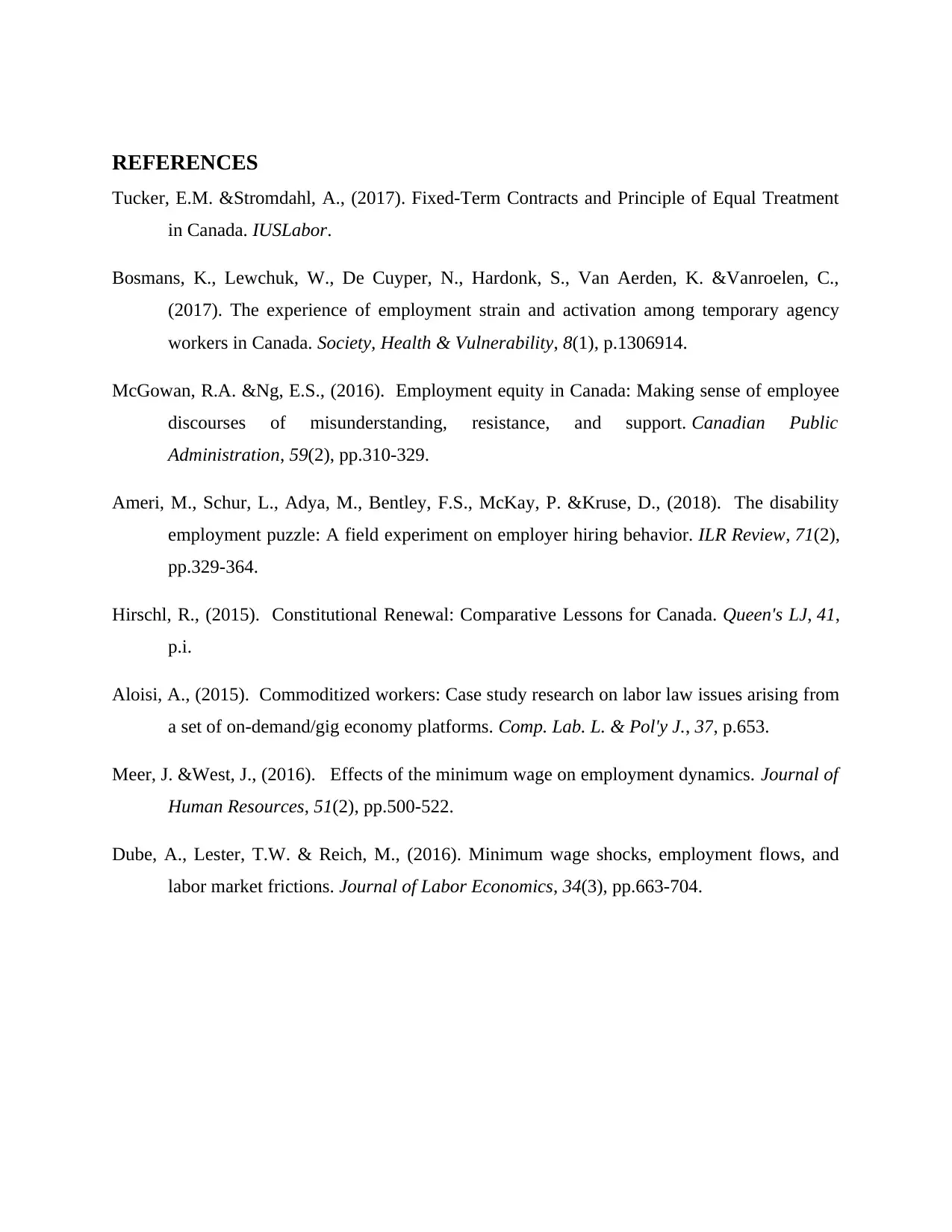
REFERENCES
Tucker, E.M. &Stromdahl, A., (2017). Fixed-Term Contracts and Principle of Equal Treatment
in Canada. IUSLabor.
Bosmans, K., Lewchuk, W., De Cuyper, N., Hardonk, S., Van Aerden, K. &Vanroelen, C.,
(2017). The experience of employment strain and activation among temporary agency
workers in Canada. Society, Health & Vulnerability, 8(1), p.1306914.
McGowan, R.A. &Ng, E.S., (2016). Employment equity in Canada: Making sense of employee
discourses of misunderstanding, resistance, and support. Canadian Public
Administration, 59(2), pp.310-329.
Ameri, M., Schur, L., Adya, M., Bentley, F.S., McKay, P. &Kruse, D., (2018). The disability
employment puzzle: A field experiment on employer hiring behavior. ILR Review, 71(2),
pp.329-364.
Hirschl, R., (2015). Constitutional Renewal: Comparative Lessons for Canada. Queen's LJ, 41,
p.i.
Aloisi, A., (2015). Commoditized workers: Case study research on labor law issues arising from
a set of on-demand/gig economy platforms. Comp. Lab. L. & Pol'y J., 37, p.653.
Meer, J. &West, J., (2016). Effects of the minimum wage on employment dynamics. Journal of
Human Resources, 51(2), pp.500-522.
Dube, A., Lester, T.W. & Reich, M., (2016). Minimum wage shocks, employment flows, and
labor market frictions. Journal of Labor Economics, 34(3), pp.663-704.
Tucker, E.M. &Stromdahl, A., (2017). Fixed-Term Contracts and Principle of Equal Treatment
in Canada. IUSLabor.
Bosmans, K., Lewchuk, W., De Cuyper, N., Hardonk, S., Van Aerden, K. &Vanroelen, C.,
(2017). The experience of employment strain and activation among temporary agency
workers in Canada. Society, Health & Vulnerability, 8(1), p.1306914.
McGowan, R.A. &Ng, E.S., (2016). Employment equity in Canada: Making sense of employee
discourses of misunderstanding, resistance, and support. Canadian Public
Administration, 59(2), pp.310-329.
Ameri, M., Schur, L., Adya, M., Bentley, F.S., McKay, P. &Kruse, D., (2018). The disability
employment puzzle: A field experiment on employer hiring behavior. ILR Review, 71(2),
pp.329-364.
Hirschl, R., (2015). Constitutional Renewal: Comparative Lessons for Canada. Queen's LJ, 41,
p.i.
Aloisi, A., (2015). Commoditized workers: Case study research on labor law issues arising from
a set of on-demand/gig economy platforms. Comp. Lab. L. & Pol'y J., 37, p.653.
Meer, J. &West, J., (2016). Effects of the minimum wage on employment dynamics. Journal of
Human Resources, 51(2), pp.500-522.
Dube, A., Lester, T.W. & Reich, M., (2016). Minimum wage shocks, employment flows, and
labor market frictions. Journal of Labor Economics, 34(3), pp.663-704.
1 out of 7
Related Documents
Your All-in-One AI-Powered Toolkit for Academic Success.
+13062052269
info@desklib.com
Available 24*7 on WhatsApp / Email
![[object Object]](/_next/static/media/star-bottom.7253800d.svg)
Unlock your academic potential
Copyright © 2020–2025 A2Z Services. All Rights Reserved. Developed and managed by ZUCOL.



